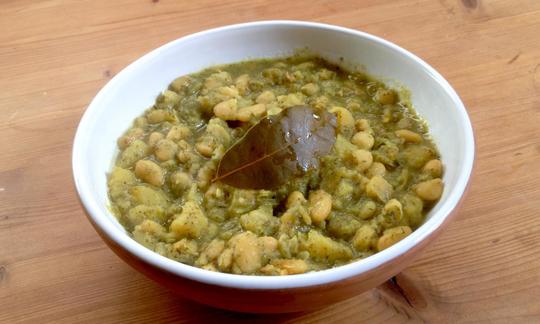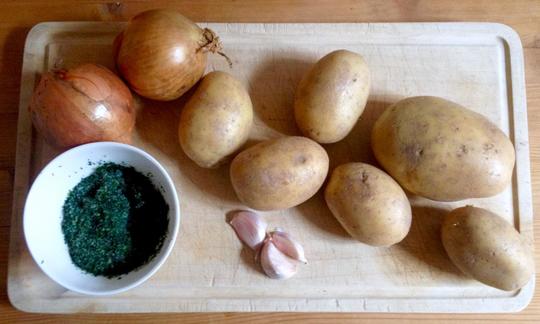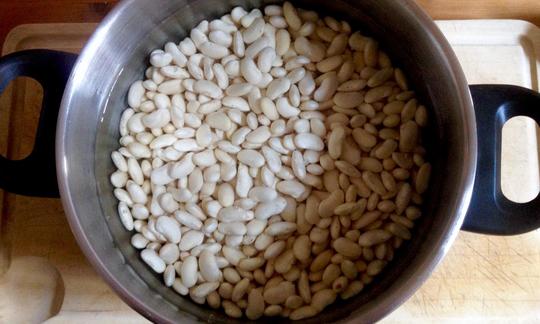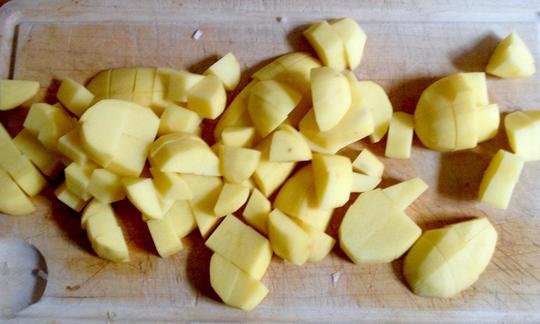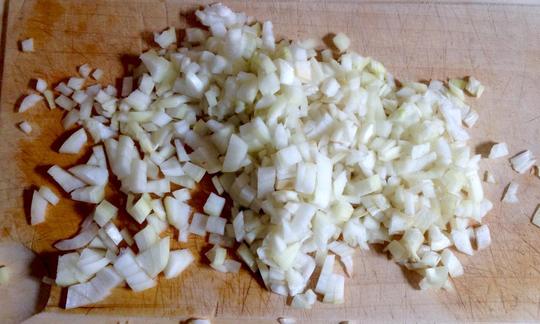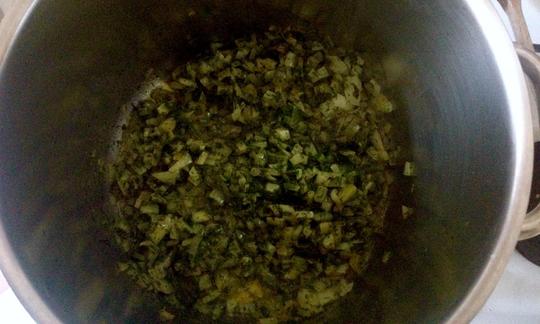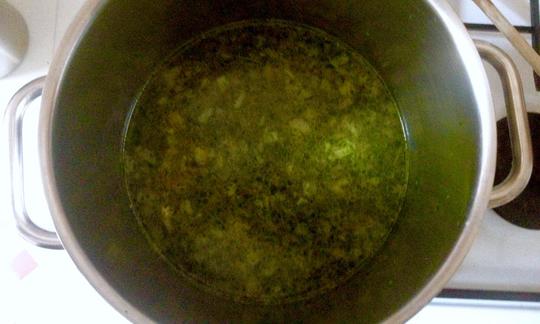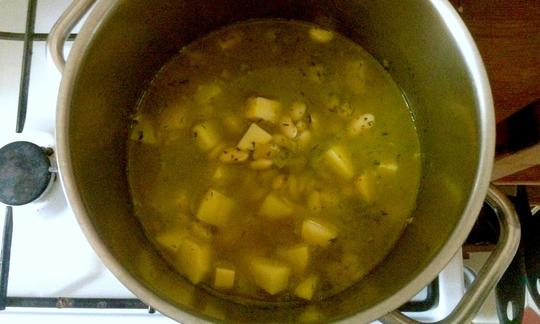Potato and bean stew with dill and onions
vegan
Ingredients (for servings, )
| For the bean base | |
|---|---|
| 11 oz | Beans, white, ripe seeds, raw (organic?) |
| For the onion mixture | |
| 2 | Onions, raw (organic?) (7.7 oz) |
| 5 tbsp | Olive oil (cold pressed, raw?, organic?) (2.4 oz) |
| 10 sprigs | Dill, raw (herb, seeds, organic?) (0.07 oz) |
| 5 cloves | Garlic (organic?) (0.53 oz) |
| 2 tsp | Turmeric (saffron root), ground, raw (organic?) (0.21 oz) |
| For the remaining components of the stew | |
| 14 oz | Potatoes, white, raw |
| 2 leaves | Bay laurel (raw? organic?) (0.01 oz) |
| 1 tsp | Sea salt (raw?, organic?) (0.18 oz) |
| ¼ | Lemons, raw (limes, organic?) (0.51 oz) |
| ½ tsp, ground | Black pepper (organic?, raw?) (0.04 oz) |
Equipment
- stove
- saucepan
- sieve
Type of preparation
- cook
- soak
- sauté
- strain
- remove the skin
Preparation
For the bean base
Soak the white beans in plenty of water for at least 8 hours or overnight. Drain through a sieve and rinse briefly before using.After soaking, the beans should be much larger and softer. If this is not the case, you may have used beans that have been stored for too long and you already know that the cooking time will be significantly longer.
For the onion mixture
Finely chop the onions and sauté them with the olive oil in a large saucepan over low heat.The finer the onion pieces, the more likely they are to 'melt' when cooked and create a creamy mouthfeel.
Wash the dill sprigs and remove any coarse parts or stems. Chop the rest into small pieces and add to the onions.
Make sure that the pot does not get too hot. The delicate dill must not burn.
Peel the garlic cloves and chop roughly. Add the chopped garlic and ground turmeric to the onions. Let everything simmer on a low heat for about 10 minutes.
In the meantime, peel the potatoes and cut them into large cubes. Set aside.
For the remaining components of the stew
Add the soaked beans to the onion mixture in the pot and stir. Fill with water until the beans are generously covered. Add bay leaves and put the lid on. Bring to the boil.Important: Do not add salt at this point as this will considerably increase the cooking time of the beans!
The water may need to be topped up during cooking, so you should keep an eye on the pot. The amount of water you add also depends on the desired consistency of the stew - more creamy and mushy or more like a soup?After the beans have been cooking for half an hour, add the potato cubes. Stir. Continue to simmer with the lid on (on medium heat).
This is the ideal case. If the beans need an hour to cook, the potatoes can cook for half an hour. However, if you notice at this point that the beans are still very hard, add the potatoes later. If the potatoes cook for too long, they will fall apart and dissolve in the stew.
The stew is ready once the beans are cooked until soft. Only then should you add the salt and let the potato and bean stew simmer for a few minutes longer so that all components can absorb the salt well.
You can find out more about cooking times for beans and pulses on the right-hand side under the "Recipe notes" section. The cooking time given refers to optimal conditions, which are not always the case.
Use the lemon piece to drizzle the juice over the stew after serving it on the plate.
|
Nutritional Information per person
Convert per 100g
|
2000 kcal | |
|---|---|---|
| Energy | 335 kcal | 16.7% |
| Fat/Lipids | 12 g | 16.9% |
| Saturated Fats | 1.7 g | 8.6% |
| Carbohydrates (inc.dietary fiber) | 46 g | 17.0% |
| Sugars | 3.5 g | 3.9% |
| Fiber | 10 g | 41.0% |
| Protein/Albumin | 14 g | 27.0% |
| Cooking Salt (Na:338.0 mg) | 859 mg | 35.8% |
| Essential micronutrients with the highest proportions | per person | 2000 kcal | |
|---|---|---|---|
| Vit | Vitamin B9, B11 (Folate, as the active form of folic acid) | 214 µg | 107.0% |
| Min | Manganese, Mn | 1.3 mg | 66.0% |
| Prot | Tryptophan (Trp, W) | 0.16 g | 64.0% |
| Elem | Potassium, K | 1'262 mg | 63.0% |
| Min | Copper, Cu | 0.61 mg | 61.0% |
| Prot | Threonine (Thr, T, irreversibly transaminated) | 0.54 g | 58.0% |
| Prot | Lysine (Lys, K, irreversibly transaminated) | 0.89 g | 48.0% |
| Min | Iron, Fe | 6.4 mg | 46.0% |
| Prot | Isoleucine (Ile, I) | 0.57 g | 46.0% |
| Prot | Phenylalanine (Phe, F) | 0.70 g | 45.0% |
Detailed Nutritional Information per Person for this Recipe
The majority of the nutritional information comes from the USDA (US Department of Agriculture). This means that the information for natural products is often incomplete or only given within broader categories, whereas in most cases products made from these have more complete information displayed.
If we take flaxseed, for example, the important essential amino acid ALA (omega-3) is only included in an overarching category whereas for flaxseed oil ALA is listed specifically. In time, we will be able to change this, but it will require a lot of work. An “i” appears behind ingredients that have been adjusted and an explanation appears when you hover over this symbol.
For Erb Muesli, the original calculations resulted in 48 % of the daily requirement of ALA — but with the correction, we see that the muesli actually covers >100 % of the necessary recommendation for the omega-3 fatty acid ALA. Our goal is to eventually be able to compare the nutritional value of our recipes with those that are used in conventional western lifestyles.
| Essential fatty acids | per person | 2000 kcal |
|---|---|---|
| Linoleic acid; LA; 18:2 omega-6 | 1.1 g | 11.0% |
| Alpha-Linolenic acid; ALA; 18:3 omega-3 | 0.18 g | 9.0% |
| Essential amino acids | per person | 2000 kcal |
|---|---|---|
| Tryptophan (Trp, W) | 0.16 g | 64.0% |
| Threonine (Thr, T, irreversibly transaminated) | 0.54 g | 58.0% |
| Lysine (Lys, K, irreversibly transaminated) | 0.89 g | 48.0% |
| Isoleucine (Ile, I) | 0.57 g | 46.0% |
| Phenylalanine (Phe, F) | 0.70 g | 45.0% |
| Valin (Val, V) | 0.69 g | 43.0% |
| Leucine (Leu, L) | 1.0 g | 42.0% |
| Methionine (Met, M) | 0.20 g | 21.0% |
| Vitamins | per person | 2000 kcal |
|---|---|---|
| Vitamin B9, B11 (Folate, as the active form of folic acid) | 214 µg | 107.0% |
| Vitamin B6 (pyridoxine) | 0.37 mg | 27.0% |
| Vitamin B1 (Thiamine) | 0.29 mg | 26.0% |
| Vitamin E, as a-TEs | 1.8 mg | 15.0% |
| Vitamin K | 11 µg | 15.0% |
| Vitamin C (ascorbic acid) | 11 mg | 14.0% |
| Vitamin B5 (Pantothenic acid) | 0.63 mg | 10.0% |
| Vitamin B2 (Riboflavin) | 0.11 mg | 8.0% |
| Vitamin B3 (Niacin) | 1.0 mg | 6.0% |
| Vitamin B7 (Biotin, ex vitamin H) | 1.5 µg | 3.0% |
| Vitamin A, as RAE | 1.5 µg | < 0.1% |
| Essential macroelements (macronutrients) | per person | 2000 kcal |
|---|---|---|
| Potassium, K | 1'262 mg | 63.0% |
| Sodium, Na | 338 mg | 42.0% |
| Magnesium, Mg | 116 mg | 31.0% |
| Phosphorus, P | 210 mg | 30.0% |
| Calcium, Ca | 144 mg | 18.0% |
| Essential trace elements (micronutrients) | per person | 2000 kcal |
|---|---|---|
| Manganese, Mn | 1.3 mg | 66.0% |
| Copper, Cu | 0.61 mg | 61.0% |
| Iron, Fe | 6.4 mg | 46.0% |
| Zinc, Zn | 2.2 mg | 22.0% |
| Selenium, Se | 7.2 µg | 13.0% |
| Iod, I (Jod, J) | 1.6 µg | 1.0% |
| Fluorine, F | 5.7 µg | < 0.1% |
The potato and bean stew with dill and onions is particularly suitable for the warm season. Just before serving, you can add a little lemon juice to round it off.
Potato varieties for the stew: Waxy potato varieties are particularly suitable here, as the potatoes should not fall apart in the stew, but rather have a buttery bite. This way, each potato cube optimally combines the overall taste of the stew. It is therefore also important not to put the potatoes in the pot right at the beginning - they need much less cooking time than the beans and would otherwise fall apart.
Raw beans and phaseolin: White beans are seeds of a garden bean plant and belong to the legumes. Raw They are inedible and even poisonous due to the lectin phaseolin they contain. The cooking process irreversibly inactivates phaseolin, making the beans a high-quality source of protein for humans. Dried white beans contain an average of 21 grams of protein per 100 grams.
Soaking the beans: You should soak the beans well before cooking to reduce the phytic acid content. Phytic acid irreversibly binds minerals in the human body, meaning that they are no longer available to the organism.
Disadvantages of pre-cooked beans: In the trade, white beans (like other types of beans and legumes) are usually dried or pre-cooked and preserved. While the preserved version is of course the more convenient and time-saving option, the dried version has the advantage of better taste. In addition, by cooking at home you can also determine the degree of firmness yourself (canned beans are often very soft, sometimes already mushy). Of course, canned goods often contain unnecessary additives or are already salted and the unprocessed version is always preferable.
Plan the preparation of the beans generously: There are a few things to consider when using dried beans. The most important thing is the age or storage: the longer and the warmer the beans have been stored (at home or in the shop), the longer the preparation or soaking time. Unfortunately, this calculation usually leaves at least one variable unaccounted for - so you should plan the preparation of beans generously. If the packet states one hour of cooking time, it could end up taking a good 2-3 hours.
Organic preserves: If you decide to go for the quick option, it is advisable to only buy organic preserves. They are often processed more gently, but above all they contain fewer or no additives. Glass preserves, which generally predominate in organic stores, are particularly recommended. These do not contain aluminum or BPA (bisphenol A) and are more environmentally friendly.
When to add salt: You should always add salt at the end of the cooking time, when the beans are already soft. Beans cook much more slowly in salted water. (You should also keep this in mind when adding soup stock, which usually contains salt.)
Quick option: If you need something quick, you can use canned beans However, this makes a big difference in terms of taste and consistency. In addition, it is much more expensive in the long run to buy canned goods.
Yoghurt combination: A combination of the stew with yoghurt makes a fresh stew variant, especially in spring or summer - served lukewarm. We recommend a vegan yoghurt for this, for example a homemade cashew yoghurt.

